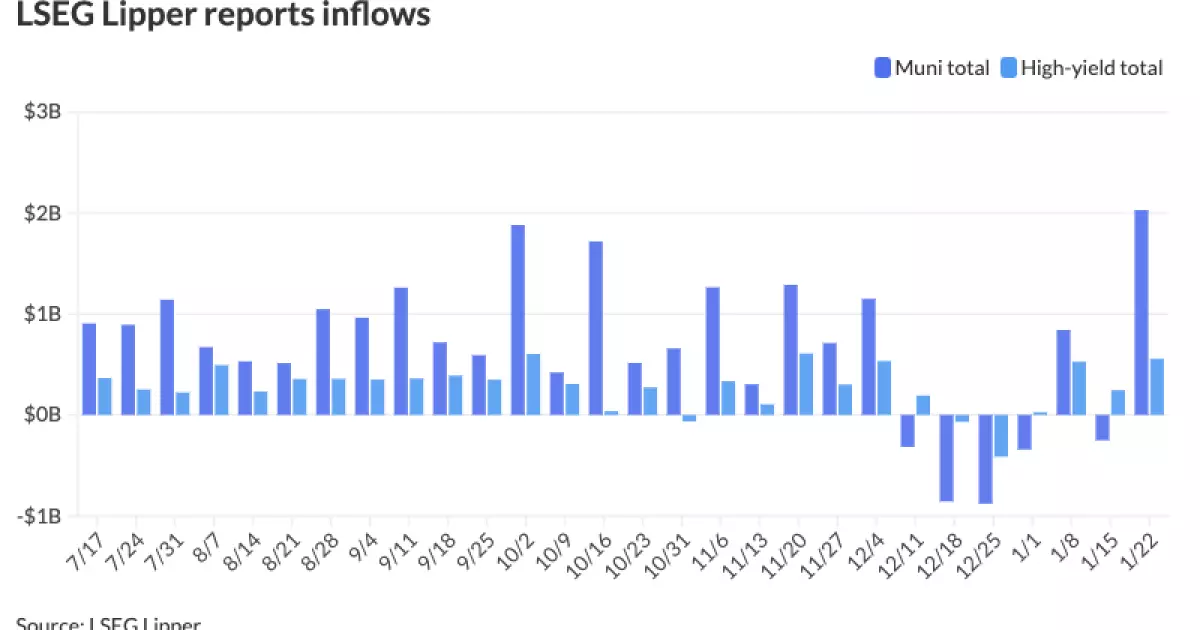The municipal bond market, often regarded as a barometer for economic sentiment, has recently exhibited a series of shifts that merit close examination. As investors grapple with fluctuating market conditions, several key developments have emerged that highlight the dynamics at play within this vital sector.
On Thursday, the municipal bond space saw a weakening trend, notably as the primary market experienced a slowdown. A significant increase in investor inflows—surpassing $2 billion into municipal mutual funds—indicates a renewed appetite for these securities despite looming challenges. This influx into the market suggests that investors are adopting a cautiously optimistic stance, reflecting an underlying belief in the stability of municipal debt as a safe-haven investment.
The relationship between municipal bonds and U.S. Treasuries remains critical, with yield ratios indicating varying levels of confidence across different maturities. The two-year municipal to UST ratio sat at 64%, while the longer ten-year and thirty-year maturities showed ratios of 66% and 83%, respectively. This divergence suggests that while short-term bonds may be responding to immediate market pressures, longer-term bonds continue to garner investor interest, possibly due to their perceived stability and reliable income streams.
In analyzing the primary market, it’s evident that the calendar has hosted a number of high-grade municipal offerings, yet this has not deterred yield pressures. As noted by industry analyst Kim Olsan, there is a persistent willingness among investors to accept lower yields in exchange for the security that municipal bonds provide. This paradox indicates a market characterized by strong demand despite a backdrop of rising yields and substantial supply.
Olsan’s insights reveal that recent offerings, such as those from Washington State and Nevada’s general obligations, have attracted surprisingly narrow spreads. Bonds that historically trade at wider spreads during periods of market weakness are now being absorbed by investors willing to pay a premium for quality. As large issues appear in the market—a rarity that fosters investor competition—bidders are finding unique value propositions that mitigate supply concerns, showcasing a resilience in market behavior.
Shifting focus to secondary market activity, recent trading volumes have been noteworthy. January’s average secondary trading is reported at $7.6 billion, marking a significant decrease from previous years. Nonetheless, as yields continue to soften this month, there’s a report of strong support across different credit ratings. AAA and AA-rated credits have displayed modest outperformance, rallying roughly 17 basis points in the ten-year tenor.
Olsan emphasizes that AAA bonds, both general obligations and revenue bonds, have constituted a substantial 26% of all trades in January—indicating strong market interest. In contrast, single-A and BBB-rated revenues held steady at 11% of daily secondary volume. This stability suggests that even amid a competitive landscape, less-rated bonds are managing to retain their appeal, potentially due to their relative affordability compared to higher-rated counterparts.
Recent bond offerings further illuminate the market’s health and investor strategy. For instance, the pricing of UMass Memorial Health Care’s revenue refunding bonds through Morgan Stanley has showcased competitive yields, demonstrating acute pricing discipline reflective of current market conditions. Similarly, Long Beach, California’s issuance of harbor revenue bonds illustrates the state’s commitment to maintaining fiscal health through strategic debt offerings.
Investor inflows into municipal bond mutual funds further substantiate this narrative. The latest data from LSEG Lipper highlights an inflow of over $2 billion, underscoring a transformation from outflows seen the previous week. High-yield funds have also garnered attention, receiving over $555 million, suggesting a thriving interest in riskier assets within the municipal space.
Looking ahead, the municipal bond market is likely to face both challenges and opportunities. While current trends indicate a robust demand for high-quality municipal bonds, the overarching risk of economic uncertainty looms large. Should tapering take place or if economic indicators show signs of volatility, investor sentiment may shift.
The inflationary pressures and rising interest rates will continue to test the resilience of the municipal bond space. However, for now, the combination of strong inflows, supportive trading volumes, and strategic offerings suggests a resilient market poised for potential growth.
While variables continue to shift, the municipal bond market’s underlying dynamics—characterized by robust demand, careful investor strategies, and an evolving economic landscape—present both challenges and pathways for strategic investment. Investors remain well-positioned to navigate this complex terrain, leveraging opportunities as they arise while remaining vigilant to potential risks.

